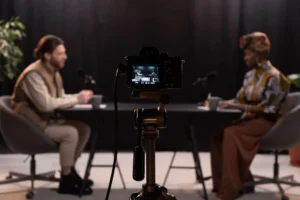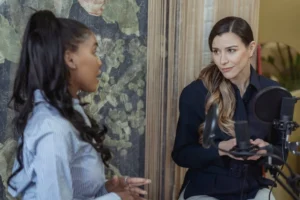Remote podcasting has become popular over the last few years. There’s no need to bring people together in the same room to produce a high quality episode. With the right tools and workflow, you can produce great content with people from anywhere in the world.
In this article, we’re going to give you an overview of what’s involved in recording podcast shows remotely. By the end, you’ll understand how to record a podcast remotely.
Benefits of Recording a Podcast Remotely
Before we dive into the how-to, let’s talk about the benefits of recording a podcast remotely.
The main benefit is that no one has to travel. Everyone can record from the comfort of their own homes or offices. This cuts down on expenses and the time you dedicate to recording.
Most importantly, however, remote podcast recording opens up a huge group of potential guests. You aren’t limited to the people within traveling distance to your recording studio. You can invite anyone with internet access.
Finally, remote podcast recording is an easy way to bring multiple people together on the same show. Instead of coordinating travel with a group, everyone just needs to log on at the same time.
Challenges of Recording a Podcast Remotely
If you want to record a post remotely, you should know that it’s not without its own challenges.
For one, everyone needs to have a reliable internet connection. You can improve sound quality by recording a double-ender (more on this in a moment), but you still need to be able to understand each other so you can have a conversation with your guest or co-host.
Second, each participant needs to record from their own recording space. Since your guest doesn’t share your space, you can’t control the environment. You will have to either educate them about how to set up a recording space, spend the time editing out all of their background noises, or just deal with their poor audio.
And third, depending on your needs, you may need to pay for remote recording software. These usually don’t cost too much (around $20/month), but it’s still an expense.
Action
Read to start your own podcast? Learn the nitty-gritty details of starting your own show in our comprehensive guide. Learn how to start a podcast.
How to Record a Podcast Remotely
Now that you understand what you’re up against, let’s talk about how to record a podcast remotely.
1. Create the right recording environment
The first step to recording a podcast remotely is to find a quiet environment. Fortunately, you don’t have to build yourself a professional podcasting studio. You just need a quiet room that doesn’t produce a lot of reverb.
Struggling with poor sound quality in your recording space? Read our full guide: Acoustic Treatment for Podcasting: 7 Tips to Eliminate Reverb
Your guests will also need their own recording spaces. These environments won’t be as good as yours, of course (unless they are podcasters themselves or spend a lot of time on the podcast circuit), so you may have to give them some tips on setting up in the right place.
2. Pick up some remote podcasting tools
Recording a podcast remotely is actually quite easy if you have the right equipment and tech. Fortunately, none of these items are very expensive. If you have recorded episodes already, you probably have some of them. Here’s what you need:
- A computer
- An XLR or USB microphone
- Mixer
- Pop filter or windscreen
- A good set of headphones
- Microphone stand
- Recording and editing software
- Podcast hosting provider
- A strong internet connection
For a complete list of our podcast gear recommendations, including specific suggestions, read our full guide: A Podcast Equipment Checklist For Any Setup Or Budget
3. Find some guests to interview
Once you’re ready to record, your next step is to find some guests. It’s easy to reach out to anyone these days, but getting their attention and convincing them to jump on an episode is a bit harder. Here are some simple places to find guests:
- People in your network or your friends’ next works.
- Authors of upcoming books.
- Commenters in Facebook and LinkedIn groups.
- Popular social media personalities or bloggers.
You can also use a guest-matching marketplace like Podmatch. It will pair you with ideal guests who are looking to join episodes. (Think of it like online dating for hosts and guests.)

Podchaser Connect is another good marketplace to find guests.

Once you find a guest who you think will make a good addition to your show, your next step is to send them a compelling email that asks them to join.
If you need help inviting guests on to your show, read our full guide: How To Invite Someone To An Interview On Your Podcast.
4. Set up your audio recording method
The best way to record remotely is by using the double-ender method. This is when each party records their audio locally (on their own computer) using recording software. The two audio files are then combined during post-production.
This method creates the best audio because it avoids many of the issues created by over-the-internet recordings. If everyone has a good mic and the conversation is stitched together properly during editing, it can actually sound like everyone is in the same room.
The downside to this method, however, is that both parties need audio recording software on their computers, which may be a challenge to set up if your guest a) doesn’t understand computers well, b) doesn’t care enough to go through the trouble, or c) isn’t recording in a place where that is possible.
To record using the double-ender method, we recommend Audacity. It’s free, reliable and user-friendly.

If you don’t want to use the double-ender method, you have a few more options:
- Squadcast – This app records great audio and lets you video conference with your guest (though no video recording). You’re more likely to have an organic conversation if you can see the other party. After the interview, download both audio files and combine them in your favourite editing software
- Riverside.fm – This app allows you to record both audio and video. The audio is studio quality and it records everything in separate tracks locally on each participant’s machine (a double-ender). It also lets listeners call into your session with video to engage and ask questions.
- Zencastr – This is one of the most popular remote recording apps because it’s been around so long. It’s similar to Squadcast. After the recording session, Zencastr will put the audio recordings in your DropBox account.
- Zoom – This is an easy to use app that most people have installed already. Guests just need to click a link to open Zoom in their browser. You can record any meeting and download the file at the end. The sound quality isn’t perfect, but the connection is quite reliable.
- Skype – This is another popular tool that recently released a record feature. All parties need to have Skype installed. The output is an MP4 (a video file), but you can easily convert them to audio-only MP3s. Skype’s main downside is it’s reliability. Connection interruptions are not uncommon.
- Phone call recordings – Believe it or not, many podcasts interview guests over the phone. The sound quality is always poor because of the limited frequency range, but they are extremely reliable. This method works best when your guest lacks reliable internet access.
5. Edit your remote podcast recording
Editing a remote podcast recording is the same as editing any other recording. If you recorded a double-ender, you’ll need to stitch the two audio files together. Then you’ll need to edit out any mistakes, background noises, distractions, or tangents in the conversation. Finally you’ll need to mix and master your audio to broadcast standards.
Learn more about editing your podcast in our complete guide: Podcast Editing: How Much Is Really Needed?
Need to help editing your show? Put your podcast on autopilot with Castos Productions. Our team of seasoned audio engineers, talented show note writers, and producers will take care of every aspect of your podcast after you record.
Best Practices for Remote Podcast Recording
Before you record a podcast remotely for the first time, we wanted to leave you with a short list of best practices. These will make the experience as painless as possible.
- Schedule a time to make a test connection with your guest before the show. This will give you both a chance to learn the technology, update the software, and ensure it captures your voices properly. This way there won’t be any problems on recording day.
- Teach your guest how to create a proper recording space, even if they have to sit in their closet surrounded by hanging clothes.
- Encourage your guest to invest in a proper microphone if they haven’t already.
- Do a test recording at the beginning of the session to ensure everything is working. Chat for a bit, download the file, and play it to make sure you aren’t forgetting something silly (like failing to turn a mic on).
- If possible, meet visually as well so you can get body language cues from the other person. This makes the conversation more comprehensive and organic.
Ready to Record a Podcast Remotely?
Now that you understand how to record a podcast remotely, you’ll be open to a much bigger pool of guests for your show. Once you get your technology stack right, you should have no trouble cranking out new episodes.
Do you record your episodes remotely? What tools and workflows do you use?



Comments are closed.